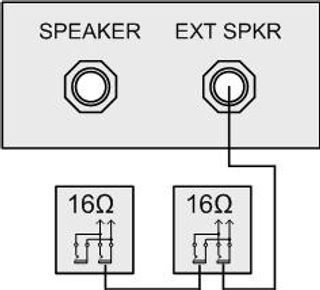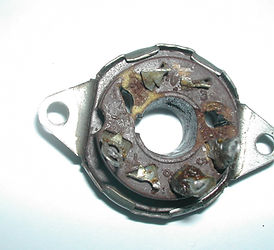

Fender Bassman 135
1) General:
Not much on the restoration of this one, but some handy details.
So, is it really a 135watt amp? Actually no, unless you're Jack Bruce. It does make an unusable 135watts at just over 10% distortion but, at clipping, it's a genuine 100watts rms with a sine wave signal. That's still pretty impressive for a company that uprated the Twin Reverb from 70 to 100watts with a typewriter. Before you buy one though, just speak to someone who's had to pick one up.

IMPORTANT: These drawings and notes are provided for interest only and are not guaranteed to be accurate. Use at your own risk and discretion. The equipment shown contains lethal voltages and should only be worked on by people with suitable training and experience. Schematics and layouts are typical but will vary.
PRINTING
Wix (bless 'em 😖) have changed their image format - again - to avif just to make them awkward to print. Unless you want to buy a converter, the easiest way to make a hard copy is:
-
Left click when the magnifying glass icon appears and wait for the picture to clear.
(On a touch screen, tap on the image). This will display a higher res file. -
Right click and 'save image as' to somewhere as an avif file.
(On a touch screen, touch and hold down to view the menu) -
Upload the saved file to your Google Drive.
-
Open the file and use the print menu to make a hard copy or save as a pdf.
2) Fender Bassman 135 Schematic

3) Fender Bassman 135 Layout

4) Fender Bassman 135 Speaker Options
The 135watt Fenders are unusual in that they have tapped output transformers. The speaker output jack sockets have automatic switching contacts which select either 4ohm or 8ohm windings.
It's not obvious from the labels but, if you plug anything into the EXT SPKR socket, it will automatically put both outputs in series and connect them to the 8ohm tap. The SPEAKER socket will just set itself to 'straight through' if not used.


ABOVE LEFT:
Rear panel SPEAKER and EXT SPKR
output jack sockets
ABOVE RIGHT:
Internal view of the SPEAKER (left) and EXT SPKR (right) output jack sockets

ABOVE LEFT:
Single 4ohm Cabinet.
Internal connections automatically switch to the 4ohm tap on the output transformer.

ABOVE RIGHT:
Single 8ohm Cabinet.
Internal connections automatically switch to the 8ohm tap on the output transformer.
RIGHT
RIGHT:
Two 4ohm Cabinets.
This is the setup shown on the back panel. The amp was usually sold as a set with a 4ohm cabinet and, with that in the SPEAKER socket, the correct impedance in the EXT SPKR socket would be another 4ohms. Hence the label.
The internal jack switching will put the speakers in series and connect them to the 8ohm tap on the output transformer.

ABOVE LEFT:
Two 8ohm cabinets with linked-through (paralleled) sockets.
Internal connections automatically switch to the 4ohm tap on the output transformer.



ABOVE RIGHT:
Two 16ohm cabinets with linked-through (paralleled) sockets.
Internal connections automatically switch to the 8ohm tap on the output transformer.
LEFT:
For two 8ohm or two 16ohm cabinets with single inputs, hard wire the cables in parallel.
-
Two x 8ohm cabs into 4ohm output.
-
Two x 16ohm cabs into 8ohm output.
5) A Few Common Problems
For a lot of reasons, the bigger Fender valve amps went out of favour a long time ago. That lead to a lot of them being stashed away in dark, damp places and forgotten about until they rolled around into fashion again. Unfortunately, in many cases, the damage has been done and you're left with some odd damp/corrosion/age related problems to sort out.
Valve Bases:
Fender/CBS octal valve bases from this period tend to suffer from leakage between the pins caused by water and cleaning fluid absorption. They're an odd size and replacing them with something that didn't leave China two weeks ago can involve opening up the chassis holes. Not difficult when you've done a few but a bit of an adventure the first time. My favourite replacements that still look the part are new-old-stock McMurdo.


Mains Selector:
The other common part to give trouble is the mains voltage selector switch. The originals had a bit of a design problem with the lugs that retain the paxolin. The back tends to bulge out after a few decades, allowing the internals to lose contact. Some newer replacements have four lugs instead of three, although Carling still supply the vintage, three lug style.

Quite often the whole lot will be chopped off and hardwired to one particular voltage. Perhaps the old 'health and safety' excuse was a handy way to save a few pounds.

ABOVE:
Vintage style, three lug voltage selector.

Pots:
Non-linear pots use a 'J' taper, making the amp sound louder at lower settings. All very well unless you're trying to get some in a hurry in Europe. Try not to fit ordinary log (audio) pots. They change the character of the controls and modern CTS ones don't actually do anything until you get towards number two on the dial. The graphs below were done on a Twin, but it's the same idea.

Biasing:
There isn't a bias current adjustment, as such, on this amp. The 'OUTPUT TUBES MATCHING' pot on the rear panel just balances the currents flowing through the two sides of the output transformer. You need to physically change R28 to alter the total current.
Hum Balance:
That's an easy one. Just adjust the pot for minimum hum through the speakers. Getting it wrong won't do any harm.
